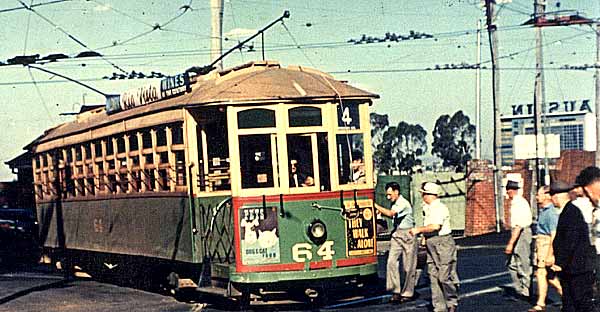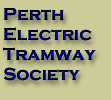
Trams in Western Australia:
|
|
|||||||||||||||||||||||||||||||||||||||||||||||||||||||||||||||||||||||||||||||||||||||||||||||||||||||||||||||||||||||||||||||||||||||||||||||||||||||||
| Perth, the capital city of Western Australia, is situated on the Northern bank of the Swan River, about 15 Kilometres upstream from the port town of Fremantle. Perth was first settled in 1829 - a British colony. Its isolation meant that for many years growth - population and economic - was slow.
In the 1890s significant gold discoveries were made in the state, notably at Coolgardie and Kalgoorlie, the latter the site of the famous "Golden Mile". These discoveries, together with increasing agricultural activity, brought increased prosperity and increased population to Perth. The population increase meant, as in other places, the development and spread of suburban living, but towns and cities could not grow beyond a certain physical size unless public transport was made available. A railway had been opened in 1881 from Femantle, through Perth, to link to Guildford and the agricultural regions beyond. Passenger services were established, and stations were built at some of the isolated settlements such as Claremont. Early suburban growth could easily follow the railway, but to develop suburbs away from the railway, an alternative form of transport was required. The tramway system which developed was a radial one, centred on Perth city, and with its major purpose to transport people from their homes in the suburbs to their work in the city. The same trams would be used for shopping trips to the big Perth stores such as Bon Marche, Aherns and Boans. As the suburbs grew, so did the tram lines. The Inglewood line along Beaufort Street, for example, had a number of short extensions of a few hundred metres, to keep pace with the expansion of housing. As in some other tramway or trolley systems in towns of rapid population growth, extensions of the system were sometimes organised, paid for, or even operated, by land developers. Trams helped in this way to sell blocks of land in Mount Lawley Estate, the Maylands subdivision, and the outer suburbs of Nedlands Park and Osborne Park. As the system developed, leisure activities began to be an important secondary focus - and no doubt a revenue earner for the tram company. Water activities were popular: two public swimming baths on the Swan River were served by the line around Mounts Bay Road - Crawley ("City") Baths and Nedlands Baths. Indeed, so popular was the Nedlands Baths area that it was for a time served by two tram lines, the other being through Subiaco. Cricket headquarters was at the WACA ground, adjacent to the Carbarn in East Perth. Football was also played at the this ground. Football headquarters at Subiaco Oval was served by the Hay St route, Loton Park (Perth Oval) was adjacent to the route along Lord St, and also close to Beaufort St, while Leederville Oval was close to the route along Oxford St. A popular destination sign was "TROTS", referring to the harness racing at what is now called Gloucester Park, also very close to the Carbarn. The Perth Zoo could be reached by the South Perth tram across the Causeway, although another popular route was by tram to Barrack Square and then Ferry to South Perth. |
Beginnings: 1899 - 1913Perth tramways were initially operated by a British company, Perth Electric Tramways Limited. The first line ran 4.8 kilometres along Hay Street, from the Carbarn in East Perth [near the WACA cricket ground] to Thomas Street, West Perth. There was a spur line serving residences along Colin St, West Perth. Track construction started on January 30, 1899, and services officially started on September 28 of that year. |
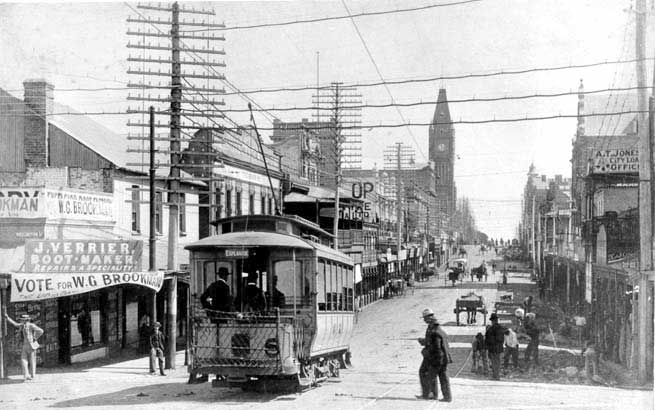 |
|
Opening day of the Highate Hill line - tram in Barrack St, south-bound for Esplanade
|
|
Further lines were built in subsequent years:
|
| These routes, together with other city track, gave a total of around 37 route kilometres by June 30, 1913. At that time there were 53 tramcars in the fleet: 44 four-wheel "single truck" cars, and 9 of the larger "bogie" cars.
The Beaufort St lines ran from a terminus at Barrack Square, which connected with the ferry service to Mends St Jetty, South Perth. |
Nationalisation and expansion: 1913 - 1930The privately run tramways were profitable, but would require funds for further expansion. The State Government decided to purchase them, and operations under government control began on July 1, 1913. The system was run as part of the Western Australian Government Railways [WAGR] - this continued until 1949 when a separate Western Australian Government Tramways and Ferries [WAGT] department was established. One advantage of the arrangement was that tramcar bodies could be economically constructed at the WAGR workshops at Midland Junction. A disadvantage was that new tram routes which might have competed too directly with the railways had little chance of approval. Knowing that its operations would be taken over, the PET Co, in its final years running the system, had naturally not wished to spend more than the minimum required amount on maintenance. The government therefore inherited a somewhat rundown system. While maintaining a cautious financial approach, the government embarked on a programme of track and fleet renewal, with some expansion. |
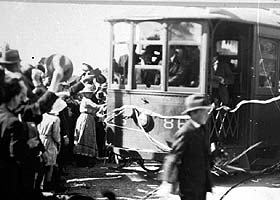 |
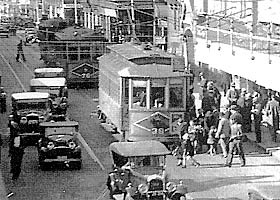 |
|
| Tramway openings were important events, greeted with enthusiasm, and sometimes a holiday for the local school children. | G-class tram #39, on route 6 to Subiaco, loads passengers as it heads a line-up of trams in Hay St, at the Perth Town Hall.
This bogie tram was one of a batch of five acquired from the Kalgoorlie tramways in 1903. |
|
Under Government ownership, the same general approach of connecting developing residential areas with the city centre continued, with links to leisure facilities being a bonus where possible. The other main system expansions occurred during this period:
Closures:
|
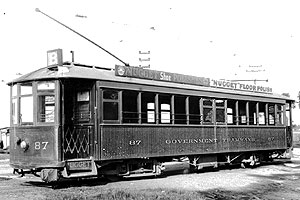 |
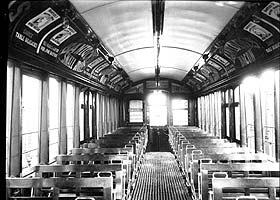 |
|
| Perth D-class tram 87, of 1921, in original condition. These trams were equipped for multiple-unit operation, that is, they could be joined into a train of several trams, with linked controllers.
The original body design, to suit Perth's climate, shows fixed windows at the end and centre of each side; the remaining sections were unglazed, but with pull-down blinds. |
The interior of a D class tram, similar to other Perth bogie cars.
This utilitarian finish, featuring wooden seats with tip-over backs, was standard. |
|
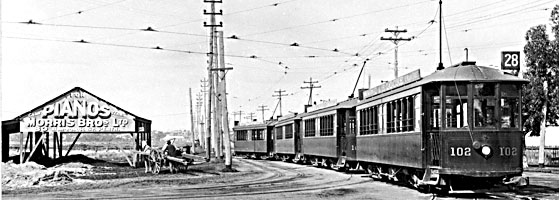 |
||
|
|
||
Depression doldrums: 1930 - 1939The worldwide depression of the 1930s had effects in Perth similar to those in many other places. Although people were less able to afford private transport, patronage on trams also suffered: due to high unemployment, fewer could afford to catch public transport. After years of steadily increasing patronage there was a sudden and marked decrease after 1930. Maintenance of the fleet and infrastructure was difficult due to financial considerations. Conversion to trolley bus operation was found to be cheaper than upgrading and converting single track lines to double track. There had been a continuing need for further tramcars to be built, but in the end this was possible only by reusing equipment from some older vehicles. As it turned out, the last new tramcar for Perth was built in 1934: #130, one of a batch of 5 "K" class. Expansions:
Closures:
|
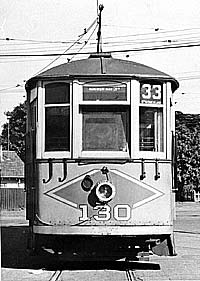 |
| K-class #130 - the last tram built for the Perth system.
This front view shows a feature of Perth trams - two sets of hooks, used for transporting perambulators. |
Wartime: 1939 - 1945Public transport demand and usage was high during the war years, caused by rationing of fuel for private transport, and by high employment, including in war-related industries. At the same time, funds were scarce, and although much of the fleet and infrastructure was of an age where maintenance would normally become heavier, much had to be "deferred". Materials and personnel directed into the war effort were also a factor. Final system expansions occurred:
Closures:
|
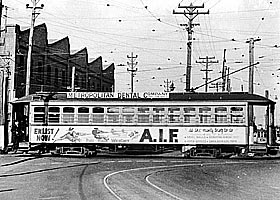 |
| A scene at the Carbarn, with a bogie car carrying recruitment advertising for the Army. |
Dismantling and closure - Why the trams stopped: 1948 - 1958The depression followed by the war had thrown together a combination of factors which needed to be considered in the post-war years: an aging tramcar fleet, aging infrastructure, years of delayed maintenance, all compounded by heavy use during the war years. The fact that much of the track was single, including some at the side of the road, would have meant additional expense if it were decided to modernise the tramway system. The shortage of funds for rehabilitation also applied to operations - buses, as well as being more flexible and cheaper to acquire, would also be cheaper to operate as they could be operated by one person, which was not possible for the Perth trams of the time. There was the additional feeling among many that trams were oldfashioned and inflexible, and their overhead wires were unsightly. Increased use of private cars, especially after the ending of petrol rationing in 1949, reduced tram patronage and increased crowding on the roads - the trams were seen as a problem for the cars. Thus it was a combination of financial problems with a lack of will to overcome them which ultimately caused the closure of the tramway system. |
Closures:
- Osborne Park line beyond Mt Hawthorn [1948]
- Nedlands route beyond Subiaco [1948]
- "Causeway" lines - Welshpool, Victoria Park, South Perth, Como [1950]
- Mt Hawthorn Oxford St [1951] - replaced by trolleybus
- Maylands [1951]
- Mt Lawley-North Perth [1953] - replaced initially by motorbus, then by trolleybus in 1958
- Newcastle St [1954] - replaced by trolleybus
- North Perth [February 1958]
- Subiaco [April 1958]
- Inglewood [19 July 1958] - replaced by trolleybus
- Osborne Park line beyond Mt Hawthorn [1948]
- Nedlands route beyond Subiaco [1948]
- "Causeway" lines - Welshpool, Victoria Park, South Perth, Como [1950]
- Mt Hawthorn Oxford St [1951] - replaced by trolleybus
- Maylands [1951]
- Mt Lawley-North Perth [1953] - replaced initially by motorbus, then by trolleybus in 1958
- Newcastle St [1954] - replaced by trolleybus
- North Perth [February 1958]
- Subiaco [April 1958]
- Inglewood [19 July 1958] - replaced by trolleybus
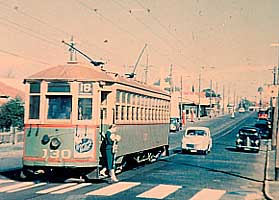
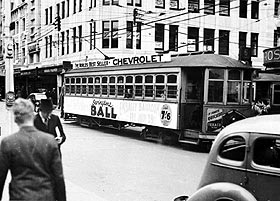
Perth tram 130 pauses for a passenger to alight in Beaufort Street, Inglewood.
A bogie tram in Hay St, crossing William St, on route 6 to Subiaco.


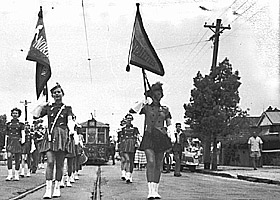 |
| Generally Perth people were saddened to see the demise of their trams, and farewelled them with due ceremony. |
Perth TramcarsThis table gives some information about the Perth tramcar fleet. |
|
numbers |
|
|
|
|
| 1 - 10 | A | 1899 | 24 seated 17 standing |
Single truck saloon. Body: JG Brill, USA Windows unglazed. |
| 11 - 19 | B | 1899 | 24 seated 17 standing |
Single truck saloon. Body: Jackson & Sharp Co., USA |
| 20 - 30 | B | 1903 | 24 seated 17 standing |
Single truck saloon. Body: St Louis Car Co., USA Wider and longer than earlier B cars. |
| 31 - 34 | F | 1903 | 64 seated 28 standing |
Bogie saloon. Body: USA [?] |
| 35 - 39 | G | 1903 | 56 seated 20 standing |
Bogie saloon. Body: JG Brill, USA Formerly Kalgoorlie Electric Tramways numbers 16 - 20 |
| 40 | B [2nd] | 1904 | 32 seated 16 standing |
Single truck saloon. Body: Perth Electric Tramway Workshops, East Perth |
| 41 - 50 | B [2nd] | 1906-7 | 32 seated 16 standing |
Single truck semi-convertible saloons Body: Westralia Ironworks, Fremantle |
| 51 - 53 | B [2nd] | 1913 | 32 seated 16 standing |
Single truck semi-convertible saloons. Body: WA Government Railways Workshops, Midland Junction |
| 54 - 61 | C | 1913 | 36 seated 9 standing |
Single truck drop-end closed combination. Body: WAGR |
| 62 | H | 1914 | 50 seated 12 standing |
Bogie centre-entrance saloon. Body: JG Brill, USA |
| 63 | I | 1914 | 50 seated 12 standing |
Bogie stepless saloon. Body: JG Brill, USA |
| 64 - 73 | E | 1917 | 64 seated 28 standing |
Bogie saloon. Body: WAGR |
| 1 - 10 | B [2nd] | 1918-19 | 32 seated 16 standing |
Single truck semi-convertible saloon. Body: WAGR Converted from original A class. |
| 11 - 30 | B [2nd] | 1914-19 | 32 seated 16 standing |
Single truck semi-convertible saloon. Body: WAGR Converted from original B class. |
| 74 - 83 | B [2nd] | 1919 | 32 seated 16 standing |
Single truck semi-convertible saloon. Body: WAGR |
| 84 - 103 | D | 1921-22 | 64 seated 28 standing |
Multiple-unit bogie saloon. Body: WAGR |
| 104 - 113 | A [2nd] | 1924 | 64 seated 28 standing |
Bogie saloon. Body: WAGR |
| 114 - 123 | A [2nd] | 1927-28 | 64 seated 28 standing |
Bogie saloon. Body: WAGR |
| 124 - 125 | E [2nd] | 1930 | 64 seated 28 standing |
Bogie saloon. Body: WAGR |
| 126 - 130 | K | 1932-34 | 64 seated 28 standing |
Bogie saloon. Body: WAGR |
